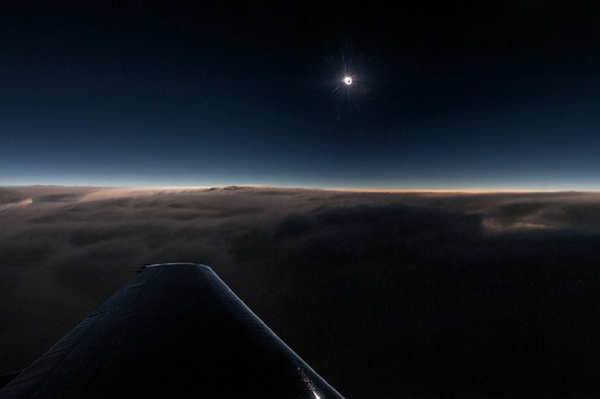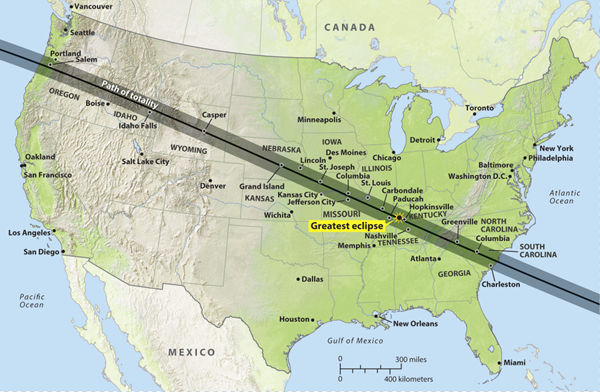This article originally appeared in Astronomy‘s June 2015 issue.
Drama is coming to the U.S. On August 21, 2017, Sun-watchers along a line from Oregon to South Carolina will experience nature’s grandest spectacle: a total solar eclipse. It’s likely to be the most viewed sky event in history. That’s why even now, astronomy clubs, government agencies, cities, and even whole states are preparing for the unprecedented onslaught of visitors whose only desire is to experience darkness at midday.
This will be the first total solar eclipse crossing the continental U.S. in 38 years (totality touched Hawaii on July 11, 1991). The last one occurred February 26, 1979. Unfortunately, not many people saw it because you had to be in (or travel to) a narrow path crossing one of just five states in the Northwest, and that winter’s weather for the most part was bleak along the path of totality. Before that eclipse, you have to go back to March 7, 1970, a total solar eclipse that moved up the East Coast, again occurring in a scant five states.
The basics
I like to think of total eclipses as examples of sublime celestial geometry. Each one is an exact lineup of the Sun, the Moon, and Earth (for a total solar eclipse) or the Sun, Earth, and the Moon (for a total lunar eclipse). And although total solar eclipses occur more often than total lunar ones, more people — actually, pretty much everyone — has seen a total eclipse of the Moon. Few, on the other hand, have seen a total solar eclipse.
The reason is quite simple: We live on Earth, and it’s our perspective that interacts with the geometry of these events. During a lunar eclipse, anyone on the night side of our planet under a clear sky can see the Moon passing through Earth’s dark inner shadow. That shadow, even as far away as the Moon, is quite a bit larger than the Moon, so it takes our satellite some time to pass through it. In fact, if the Moon passes through the center of Earth’s shadow, the total part of the eclipse can last as long as 106 minutes. Usually totality doesn’t reach that duration because the Moon passes either slightly above or below the center of the shadow our planet casts.
Conversely, the Moon and its shadow at the distance of Earth are much smaller; so small, in fact, that the shadow barely reaches our planet’s surface. Anybody in the lighter outer region of the shadow (which astronomers call the penumbra) will see a partial solar eclipse.
The lucky individuals under the dark inner shadow (the umbra) will experience — a much better word than “see” — a total solar eclipse. Sometimes, only the Moon’s penumbra falls on Earth, and the eclipse is partial everywhere. Not in August 2017.
A question people often ask is, “Isn’t the Sun a lot bigger than the Moon, so how does the Moon cover it so exactly?” Yes, the Sun’s diameter is approximately 400 times larger than that of the Moon. What a coincidence that it also lies roughly 400 times farther away. This means both disks appear to be the same size.
Regarding timing, all solar eclipses happen at New Moon. Unless the Moon lies between the Sun and Earth, it can’t block any of our star’s light. The only lunar phase when that happens is New Moon.
But why doesn’t a solar eclipse happen at every New Moon? The reason is that the Moon’s orbit tilts 5° to the plane formed by Earth’s orbit around the Sun, which astronomers call the ecliptic (because that’s the only place eclipses can occur).
Most of the time, our satellite is either north or south of the ecliptic. But during each lunar month, the Moon’s orbit crosses that imaginary plane twice. Astronomers call these intersections nodes.
Solar eclipses only occur when the Sun and the Moon lie at the same node. Unfortunately, during most lunar months, the New Moon lies either above or below one of the nodes when the Sun is there, and no eclipse happens. On average, a total solar eclipse occurs somewhere on Earth about once every 16 months.
But the average length of time between two total solar eclipses at a specific location on Earth is much longer: 330 years in the Northern Hemisphere and 550 years for locations south of the equator.
The difference between the hemispheres is due to two factors: 1) More eclipses occur during summer months (more hours of daylight); and 2) the Northern Hemisphere lies farther from the Sun during its summer, making our daytime star a smaller target (hence, easier to cover).
The maximum length of totality also varies from one eclipse to the next. The reason comes from the fact that Earth is not always at the same distance from the Sun and the Moon is not always the same distance from Earth. The Earth-Sun distance varies by 3 percent and the Moon-Earth distance by 12 percent.
The result is that the Moon’s apparent diameter can range from 7 percent larger to 10 percent smaller than the Sun. A bigger apparent size for the Moon and a smaller one for the Sun equals a longer totality. But a Moon that looks smaller and a Sun that appears larger means that you’ll experience a shorter time in the dark.
According to Belgian astronomer Jean Meeus, the maximum duration of totality from 2000 b.c. to a.d. 3000 is 7 minutes and 29 seconds. That eclipse will occur July 16, 2186, so don’t get too anxious.
The length of totality during the August 21, 2017, eclipse won’t be nearly that long.
Its duration will vary according to your location. Where the Moon’s umbra first touches land, at Government Point, Oregon, totality lasts 1 minute and 58.5 seconds. The maximum duration, 2 minutes and 41.6 seconds, occurs just south of Carbondale, Illinois.
Everyone in the contiguous U.S. will see at least a partial eclipse. In fact, if you have clear skies on eclipse day, the Moon will cover at least 48 percent of the Sun’s brilliant surface. And that’s from the northern tip of Maine. But although our satellite covering part of the Sun’s disk sounds cool, you need to aim higher.
Likening a partial eclipse to a total eclipse is like comparing almost dying to dying. If you are outside during a solar eclipse with 48 percent coverage, you won’t even notice it getting dark. And it doesn’t matter whether the partial eclipse above your location is 48, 58, or 98 percent. Only totality reveals the true celestial spectacles: the two diamond rings, the Sun’s glorious corona, 360° of sunset colors, and stars in the daytime.
But remember, to see any of this, you must be in the path.
That said, you want to be close to the center line of totality. The fact that the Moon’s shadow is round probably isn’t a revelation. If it were square, it wouldn’t matter where you viewed totality. People across its width would experience the same duration of darkness. The shadow is round, however, so the longest eclipse occurs at its center line because that’s where you’ll experience the lunar shadow’s full width.
Yes, we’re sure
This event will happen! As astronomers, some of the problems we deal with are due to the uncertainty and limited visibility of some celestial events. Comets may appear bright if their compositions are just so. Meteor showers might reach storm levels if we pass through a thick part of the stream. A supernova as bright as a whole galaxy may be visible, but you need a telescope to view it. In contrast to such events, this solar eclipse will occur at the exact time astronomers predict, along a precisely plotted path, and for the lengths of time given. Guaranteed. Oh, and it’s a daytime event to boot.
After the 2017 event, the next total solar eclipse to track across the continental U.S. occurs April 8, 2024. It’s a good one, too. Depending on where you are (on the center line), the duration of totality lasts at least 3 minutes and 22 seconds in eastern Maine and stretches to 4 minutes and 27 seconds in southwestern Texas.
After that eclipse, it’s a 20-year wait until August 23, 2044 (and, similar to the 1979 event, that one is visible only in Montana and North Dakota). Total solar eclipses follow in 2045, 2052, and 2078.
But it’s 2017 that’s causing all the excitement now. Stay tuned to Astronomy and Astronomy.com for much more information about this event. Future stories will discuss trip planning, how to observe the event, top locations for activities and viewing, and much more. We’ll keep you informed so that you can approach the eclipse without a shadow of doubt.











